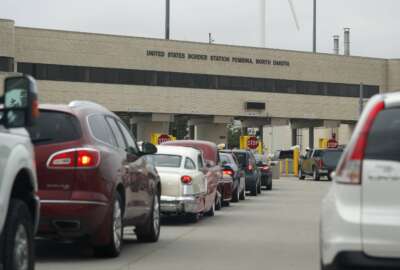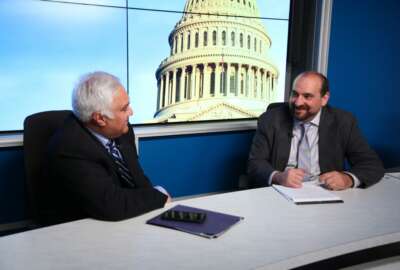
Customs and Border Protection launches latest update to a very old system
The Automated Commercial Environment is an old system operated by Customs and Border Protection. It supports the movement and fees collection of ship cargo moving...
The Automated Commercial Environment (ACE) is an old system operated by Customs and Border Protection. It supports the movement and fees collection of ship cargo moving in and out of the United States. It might be old, but CBP has updated this system several times over the decades. Now, using a chunk of money from the Technology Modernization Fund, CBP has overhauled a crucial module in the Automated Commercial Environment. The Federal Drive with Tom Temin got some of the details from the executive director of CBP’s trade transformation office, James Byram.
Interview transcript:
Tom Temin
Just briefly review the genealogy of the system ACE, it was called something different, but it does go back. It has a lineage that’s pretty old in the annals of federal computing, doesn’t it?James Byram
Yeah, it does. Trade processing within U.S. Customs Service, now CBP, actually originated in an automated fashion back in the mid 1980s, under the name of the Automated Commercial System. Back in the early 2000s, CBP took it upon itself to modernize those processes. And that turned into what is now known as the Automated Commercial Environment, sometimes also referred to as the single window, because we do interface with 49 other federal agencies now.Tom Temin
Right, and I mentioned at the top that it supports shipping, in and out. But maybe give us a little bit more detail on precisely what it does.James Byram
Sure, just understand the scope of of ACE. Just consider the scale of trade that goes in and out of the United States. So all of this is being processed through a song on a daily basis. In fiscal year ’22, there were 372 million cargo entries, 21 million export shipments that were processed through ACE this past fiscal year. The value of those imports totaled $3.4 trillion. And exports totaled about $2.1 trillion dollars. And all of that activity generated over $114 billion in duties, taxes and fees for the U.S. federal government. So on a typical day, CBP processes through ACE, $9.32 billion worth of imported goods, over 108,000 entries come in through our air, land and sea ports. And about $312 million in duties, taxes and other fees are collected and more than 91,000 truck, rail and sea containers are processed each day, all through the ACE system.Tom Temin
Yeah, all you have to do is take a cruise ship out of Fort Lauderdale to get some sense of the extent of just one port and how much stuff comes in and out when you see those stacked up containers. And ACE, over the years, has moved the transactions further and further out, such that when a ship actually arrives, a lot of it has been completed and it speeds up the volume. Is that a fair way to put it?James Byram
Yes, with the modernization that we’ve done over the past few years, the prearrival processes, so the manifesting of the cargo across multiple modes of transportation. So whether it’s air, ocean, rail, truck, there are guidelines and requirements that industry has to follow, with regard to the reporting requirements for the data they have to submit to CBP and the other 49 federal agencies that oversee trade within the United States. And so with some of these enhanced processes, modernized processes that we’ve rolled out over the past few years, it does allow for the prearrival data to get to CBP and those other government agencies, well before cargo arrives. Gives them an opportunity to screen it and make some informed decisions around risk management and enforcement.Tom Temin
And as the Trade Transformation Office executive director, are you mainly on the technical side or on the policy program operations side?James Byram
My office kind of has a foot in both camps. My team works hand in hand with the technical teams, to develop enhancements or maintain the current ACE system. But then we also liaise between the the business side, as well, to gather requirements and ensure that those requirements are met by the technical side.Tom Temin
Yeah, this is a big part of CBP, isn’t it? And this is pretty mission critical, as well as having huge financial import.James Byram
Exactly. The system itself is there to help not only collect data, and we provide the data to the other government agencies for many different reasons, not just enforcement, but also for statistics. And within CBP, the modernization of those processes helped to execute and advance the trade mission within the federal government.Tom Temin
We’re speaking with James Byram. He’s executive director of the Trade Transformation Office at Customs and Border Protection. Tell us about the [Technology Mondernization Fund] money and what you’ve done with it, to update one part of the ACE? Tell us what this part actually does.James Byram
A couple of years ago, back in FY20, we actually applied for TMF money. So the ACE program, as well as other CBP initiatives. So we receive appropriated funds annually to address projected development and operational needs for each of those programs. ACE is not unique in that area, in cases where additional funding is needed, and depending on the type of the project. We’ve got various avenues to explore to secure the needed funds in any given fiscal year. And the technology modernization fund, or TMF, was one such avenue that we took a chance on and applied for some funding. We had an area within ACE within the Cargo Processing. It’s the collections process, the process that actually collects and reports on the duties taxes and fees for CBP that was in need of modernization. Up until that time, it existed on the legacy mainframe, it was not part of the modernized infrastructure. We had started that effort back in 2018, we didn’t have the funding on hand to be able to complete the project. So we went to the TMF. And were able to, or got approved for a $15 million short-term loan. And that came in two tranches. So we got a portion of it in FY20, and the last portion of it in FY21. And that funding was used to support the fourth, fifth and sixth releases of our collections effort; there’s a total of seven releases. So the first three releases, we had the funding for. The middle three, we did not have the funding for. And through the budgetary process, we were able to align funding for the seventh release.Tom Temin
All right, so now these releases are finished. And what is the difference? How do they work now versus how they worked? Maybe I hear a little cloud coming on here.James Byram
Exactly. So all new development that we’re doing on the ACE environment, and even some of the legacy processes have been transitioned over to a cloud environment. But all new development is happening in the cloud. That allows us to do a few things. It gives us better ability to scale, whenever we have to scale up for more processing or scale down because activity is low. And it’s also been a big contributor to reducing latency of processing trade and collections data.Tom Temin
And when you collect these funds, these duties, taxes and fees. It’s often, I think I’m correct here, from foreign owned and foreign operated ships and cargo handlers. So there’s an international aspect of funds collection to all of this?James Byram
A bit; most of the duties are paid by the importer. And most of those importers are here domestically. So really, it’s the U.S. is paying those duties. It’s not the foreign manufacturer, or the producer of those goods, or the exporter, necessarily, from another country that’s actually paying those duties. Some of the fees that are collected are related to the carrier. So potentially those carriers are foreign. And they’re exporting from their country and being imported into the U.S. And there’s some fee collection there. But primarily, the duties are domestically paid.Tom Temin
But it sounds like a pretty complex set of logic that is operating here. Because you have on a given ship, there could be, I don’t know, 100 different importers and manufacturers, all those containers have something different from a different source in them. And you’ve got the different ships. And so there’s a lot of back and forth from Overland and to see passing through the ACE and the collection module?James Byram
Yes, there’s many different parties involved in a particular transaction. You have the importer, you have the carrier who’s transporting the cargo, because there are duties, taxes and fees involved. And some of those, most of the time, they’re not paid upfront, they’re usually paid after the fact. And because of that, there’s kind of a surety that’s involved, a bond involved so that if duties, taxes and fees are not paid on time, CBP has a way to get the money. So there’s charities involved, there’s licensed customs brokers involved, because they do most of the filing on behalf of importers. There’s software vendors, service providers, they provide automation to industry to interact and transact with CBP systems. So there’s many different actors. And there’s tons of data that we collect, there’s tons of reference data that we use to to validate data and verify that the parties are legitimate and that the data is accurate, that’s being submitted.Tom Temin
So therefore, the modernization work has to really take into account what is going to be facing all of those multiple parties, when you finally reach the point that you’ve deployed it.James Byram
Right, so modernization is not just focused on CBP, when it’s modernizing its system. Those who interact with the system also have to make changes. So industry is having to make changes to their systems in response to our changes. Partner government agencies that are part of the overall trade process, they have to modernize their systems or enhance their systems in response to ours as well. So it’s very orchestrated, very coordinated, a lot of collaboration with industry, other government agencies and CBP, to pull this thing off.Tom Temin
And if you could, just briefly and we’ll wind up here, is maybe describe the technical environment now that you have.James Byram
Right. Everything new is developed and hosted on the cloud. CBP is also, I wouldn’t say in the middle, we’re kind of closer towards the end than we are to the middle, of migrating all their systems to a cloud based environment. ACE is one of those. So ACE, kind of as a system has been around since the early 2000s. So there’s still some legacy infrastructure there that needs to be migrated, those processes migrated over to the cloud. But the majority is cloud based. And the development that we’re doing, we’re using an agile development process. We’ve been doing that on ACE since 2012, when we had started that and started making huge advancements and being able to roll product out.Tom Temin
So you would characterize this as a TMF success story?James Byram
Oh, definitely. In sessions with the TMF working group, and then quarterly sessions with the TMF board, great feedback from those groups on on our efforts. So we were able to successfully use the funding that we received and produce exactly what we expected to produce, with that funding.
Copyright © 2025 Federal News Network. All rights reserved. This website is not intended for users located within the European Economic Area.
Tom Temin is host of the Federal Drive and has been providing insight on federal technology and management issues for more than 30 years.
Follow @tteminWFED
Related Stories

CBP takes $15M loan to speed up revamp of 30-year-old system
 Exclusive
Exclusive 


